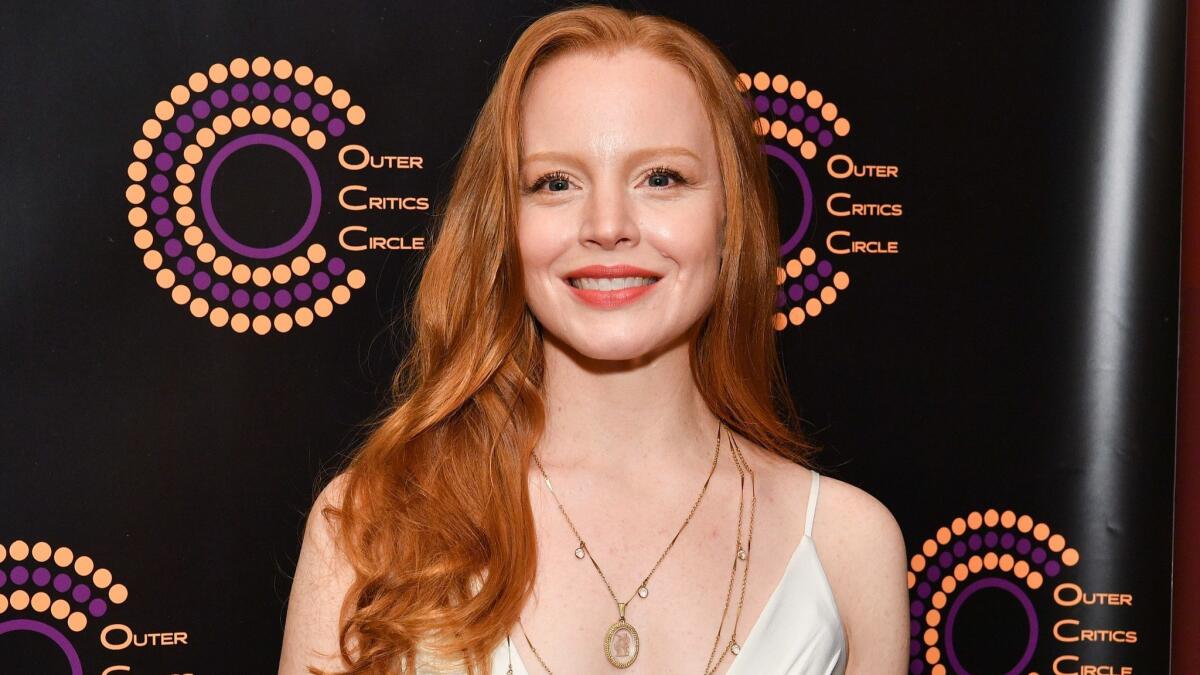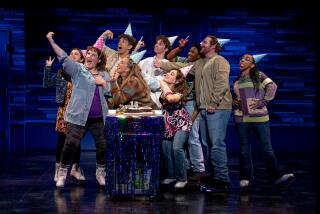Lauren Ambrose on a ‘My Fair Lady’ for a new generation
The era of Times Up and #MeToo might seem like the exact wrong time to revisit “My Fair Lady,” the 1956 Lerner & Loewe classic about a phonetics professor who, as part of an amusing bet, trains cockney working-class girl Eliza Doolittle to pass as a “loverly” prize of high society.
The single fortysomething academic Henry Higgins addresses his young student with condescension, misogyny and objectification, referring to her as a “presumptuous insect” and “this thing I created out of the squashed cabbage leaves of Covent Garden.”
For the record:
8:30 a.m. June 7, 2018An earlier version of this article said suffragettes appear in the first musical number. They appear in the first act but not in the first number. Also, Allan Corduner’s name was misspelled as Alan in a photo caption.
But in fact, Lincoln Center Theater’s first Broadway revival of the musical in 25 years — up for 10 Tony Awards on Sunday — manages to highlight the female-empowering aspects of the “Pygmalion”-based tale without changing a word of the original text. Suffragettes traverse the Vivian Beaumont Theater stage in the first act, and Henry’s mother (played by Diana Rigg) lands a slew of scathing one-liners at the expense of her son, a societal success but a personal disappointment.
Most notably, the enlightened satire is driven by its star, Tony nominee Lauren Ambrose, who demonstrates the palpable strength of her Eliza — vocally, comedically and emotionally — in a way that positions her as an admirably willed and resilient female character.
“People described the show as a guy who finds this girl and transforms her, but the reality is, she is incredibly witty and smart and clever,” Ambrose says. “She’s the one who overhears his address, goes to his house and says, ‘I’m here for lessons, I’m gonna better myself, I’m gonna transform my life.’ It’s remarkable, I can’t imagine doing this show at any other time. It’s so resonant for right now, and you can feel it in the room every time.”
The room is feeling it, for sure. Times theater critic Charles McNulty noted Ambrose’s smart, soulful portrayal, “honoring Eliza’s alert mind as she lends dignity to the character’s trampled upon feelings.” The New York Times’ review carried the headline, “Whose ‘Fair Lady’? This Time, Eliza’s in Charge.”
So why was the original musical so sympathetic to the misogynistic male lead, originated by Rex Harrison?
“Maybe that has to do with who was playing the part when they were creating the musical — he was a powerful person, as opposed to the 20-year-old actress playing Eliza,” Ambrose says of Julie Andrews, then a stage ingenue. “But it’s all there in the text, this antique material from 100 years ago, when George Bernard Shaw wrote ‘Pygmalion’ in 1913. It’s the first thing I noticed when I read it, and it was very moving to me.”
Like Eliza, Ambrose was the one who first reached out — in this case, to “My Fair Lady” director Bartlett Sher. Although the actress is best known for playing the rebellious Claire Fisher on the HBO drama series “Six Feet Under” (and earned two Emmy nominations for it), Ambrose is a classically trained singer, albeit one who hadn’t performed in a musical since high school.
I can’t imagine doing this show at any other time. It’s so resonant for right now, and you can feel it in the room every time.
— Lauren Ambrose on “My Fair Lady”
Amid a few TV pilots and film roles, she had made her Broadway debut in Sher’s staging of “Awake and Sing!” She also had played Juliet and Ophelia in New York’s Shakespeare in the Park and costarred in the “Exit the King” revival on Broadway. She was set to star in Sher’s Broadway-bound revival of “Funny Girl,” but the 2012 production was scrapped weeks before its tryout run in Los Angeles.
Expectations for “My Fair Lady” — which Sher calls “the hardest musical in the universe to do” — were especially high because of Audrey Hepburn’s indelible performance in the 1964 movie.
“But Audrey Hepburn didn’t sing it. It was a beautiful performance, but it wasn’t a real [one],” Sher says, noting how Marni Nixon dubbed vocals for Hepburn.
The casting of Ambrose, a 40-year-old mother of two, as the twentysomething Eliza bewildered some theater folk, but Sher says that “to get someone who can do all of this, it’s always a surprise. And every single time I’ve ever worked with her, she came in and gave the best audition I’ve ever seen, until the next time she came in for something else.”
The stars of “Mean Girls,” “Once on This Island,” “Summer: The Donna Summer Musical” and Rodgers & Hammerstein’s “Carousel” also have been nominated for lead actress in a musical, but most prognosticators see Ambrose going head-to-head with Katrina Lenk of “The Band’s Visit.”
Setting awards predictions aside, Ambrose says she’s “honored with the responsibility” of Eliza, an iconic role she plays with a little bit of bloomin’ luck.

TONY AWARDS: Lindsay Mendez rides ‘Carousel’ to a nomination »
“It’s a miracle that any job comes together. It’s all so fragile and pretty wonderful that it all worked out,” she says. “But it’s like the song she sings at the end: ‘Without your pulling it, the tide comes in / without your twirling it, the Earth can spin.’ ‘My Fair Lady’ and Eliza Doolittle will go on long after me, and someone else will step into it for their moment. That’s what’s so beautiful about revivals: There have been so many interpretations, and we’re just giving it what we can.”
To do so, Ambrose trained with acclaimed Juilliard voice and speech teacher Elizabeth Smith to get Eliza’s cockney-turned-posh accent evolution just right — and without too much tension, so she could still showcase her soprano. She and the cast also met with an Edwardian scholar to learn about how limited the possibilities were for a poor flower girl, or even an educated woman of society, during the time the play is set.
“It was eye-opening, because the real transformation begins in Act 2, after the ball, when Eliza realizes that, yes, she wanted this, but now what is she gonna do?” Ambrose says. “She’s now beholden to all of these societal structures, and she was actually freer as a flower girl: She could stay out at night, she could go or do wherever she wanted, she could make her own hours. As much as this show is about gender, it’s also about class.”
The musical’s ending has been the subject of debate over the years. While both stagings see Eliza returning to Higgins’ home after a heated argument, it reads in the original production as an act of submission, with Eliza settling for an inevitable post as Higgins’ wife. With the approval of the Lerner and Loewe estates, this final moment has been reinterpreted in the revival as a meeting of mutual equals, followed by a few clever stage directions that leaves Eliza free to soar.
A throwaway comment from that Edwardian scholar sticks out to Ambrose regarding this scene. “I showed her images of our costumes and she said, ‘Well, looking like that, she could probably go to a bank, get a line of credit and open her own flower shop or phonetics studio or whatever it’s gonna be. She could buy herself a room with an enormous chair.’”
As for Ambrose, “I like to think that she leaves Higgins and goes on to join the suffrage movement.”
See all of our latest arts news and reviews at latimes.com/arts.
More to Read
The biggest entertainment stories
Get our big stories about Hollywood, film, television, music, arts, culture and more right in your inbox as soon as they publish.
You may occasionally receive promotional content from the Los Angeles Times.











